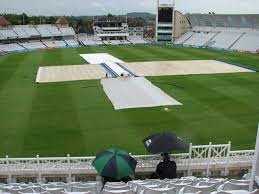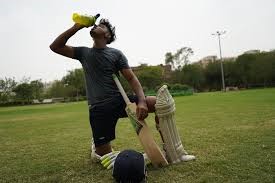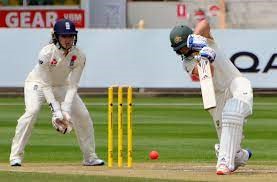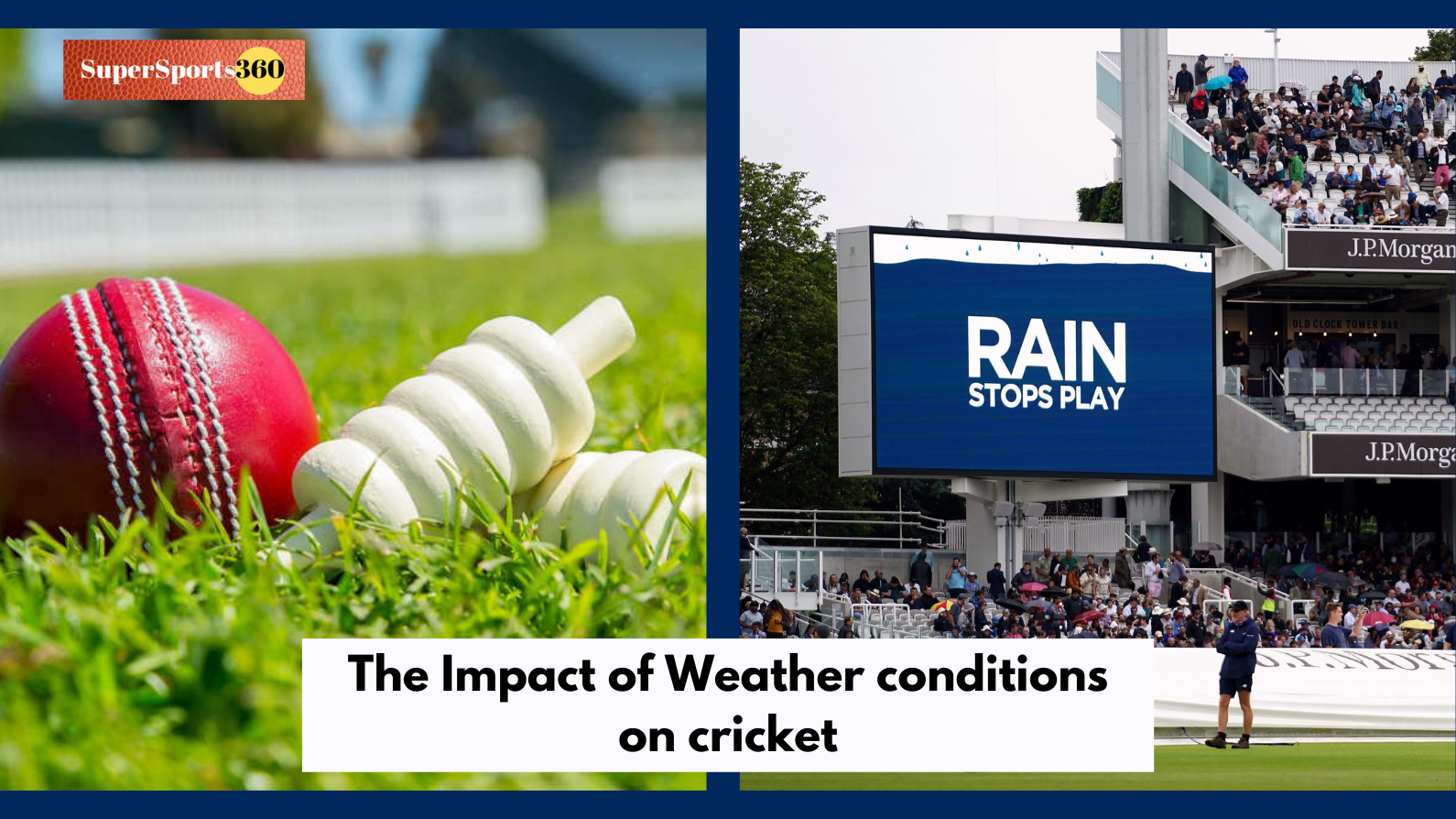Weather Impacts the game of cricket more than other outdoor sports. The Impact of weather conditions on cricket is vital as it influences the decision taken during toss and the captain who wins the toss have a distinct advantage to choose to bat or ball. Other factors also play a part based on the weather conditions which play a huge role to determine the final result of the match.

Depending on the weather conditions, captains decide on their team to be fielded for the match and players who suit that particular weather conditions are considered in the playing level, a case of Horses for Courses
A sunny day will help batsman in scoring runs more comfortably as compared to an overcast conditions which ideally suits the swing bowlers. We will discuss in detail the Impact of weather conditions on cricket
Presented by: Raghunath Nair
Date: 19/06/2023
Introduction

Cricket is normally played in all seasons except for monsoons. Home team plays important series in seasons which suit their style of play. Batsman prefer clear blue sky when they bat as it will cut down the movements of the ball before pitching. This is also called the Swing. Though a skillful bowler can rely on movement after the ball is pitched which is also called the Seam.
Weather plays a huge role on Pitch conditions and when sun beats on the pitch surface for a long period of time, it will dry out all the moisture present in the pitch making it a belter of a wicket helping in strokeplay. High Scores are predicted and scored on clear days and Low Scores and Wickets dominate an overcast condition.
In an over cast condition, bowlers love to use the conditions to their advantage and a skillful bowler can create havoc on the batting side with swing and seam which becomes unplayable. This is a condition which will be considered similar to English or NewZealand conditions.
Cricket is an unpredictable sport and Weather also plays a vital part in its unpredictability.
While a strong team with individual talent and teamwork dominates the game, other factors like weather, pitch conditions also play a crucial part in the final outcome of the game.
While Weather being the most unpredictable of all the external factors, it becomes very challenging for teams to be picked on the conditions alone.

Factors affecting the game of Cricket
Pitch Conditions: Conditions of the pitch primarily depend on its freshness, moisture content and soil type.
Dry surfaces: In case the Pitch prepared is dry, any excess sun beating on the surface of the pitch will crack open the surface and make it ideal for spinners to grip the ball off the surface of the pitch. The nature of the soil will help the degree of bounce the pitch will offer.
Green Pitches: These pitches have significant amount of moisture and grass cover due to excessive watering or due to overnight rain. Such green tops will help ball to move in the air and off the pitch. This will become challenging for batters to play their natural shots and will play caution to the winds. But a warm and sunny day can quickly dry out a green top and make it into a batting friendly wicket
Flat Pitches: These are batters pitches ideally suited to play shots. Flat pitches do not assist in swing or seam and the bounce will be consistent with little or no lateral movement allowing big scores. Bowlers toil hard in such pitches and are ideally suited for shorter format games and not an ideal test match wicket.
Weather Conditions and Its Impact on Cricket:
Cricket is played over a period of 6- 8 hours and the pitches can change its character based on weather conditions making it very unpredictable to know the outcome in advance.

Effect of Rain
Rain affects all concerned, Batsman, Bowler and fielders alike. Batsman find it difficult to sight and time the ball , Bowlers find it difficult to grip the ball and fielders find it dangerous as the wet outfield can cause serious injuries.
While an overcast condition has a positive effect on the bowlers, but game resumed after a brief rain break may not be as useful to the bowlers and due to the wet outfield ball tend to become heavy and the swing and seam suddenly disappears.
Baring few countries, the entire playing area of the ground is not fully covered during a rain break and when game resumes after a rain break, the uncovered areas of the ground will be moist and when the ball runs on to the outfield, the ball tends to become slippery and difficult to grip which becomes hard for slow and fast bowlers.
Effect of Dew

In a day Night match, dew plays a major role especially in subcontinental conditions. With warm weather in the day and drastic weather drops in the second innings, when the lights are in effect, dew takes effect which makes bowling difficult due to slippery conditions. Bowling becomes easier to face as ball loses swing and seam and becomes an easy chaseable ground. That is why captains prefer to chase in a day night ODI or a T20 International.
Effect of Humidity
Humidity plays an important part in how the ball behaves. It affects the weight and swing of the ball.
When the humidity is high, the ball can become heavier, making it challenging for the bowlers to generate swing.
However, when the humidity is low and the climate is rainy then pitches also have lots of moisture in them the ball can swing more, making it harder for batters to play their shots. The Pitches also start to sweat below the surface which allows the bowlers in the extra swing and bounce. The pitch takes time to dry allowing bowlers to dominate for a longer time.
Effect of Wind
Strong winds also hampers play as batsman tries to score only along with the wind and bowlers find it difficult to control the swing
Effect of Heat and Humidity

Heat can have an effect on bowlers and batters. Played usually in summers, cricket can be a difficult sport especially in subcontinental conditions.
Heat and Humidity related illness have gone up on modern cricket as the game has become harder and more physical.
Cricket gears used only adds to the discomfort of the heat. Play has been halted in NewZealand due to extreme heat.
Players have been hospitalised like Dean Jones after spending eight hours facing the Indian bowlers and the Chennai heat.
Joe Root was even forced to retire due to heat in one of the ashes series in Australia.
Effect of Extreme Cold Conditions
In extreme cold conditions, the ball do not swing may become harder and less responsive, making it more difficult for bowlers to generate swing and pace. Fielders struggle in colder conditions.

Famous matches getting affected by Rain
Rain delays and halt play. In some occasions, matches get abandoned and thus altering the predicted results of the game. Who can forget the luck, rain brought for the Pakistani team in the 1992 finals when a lost final game for the Imran Khan led team got abandoned by rain and had to be replayed as a fresh game which Pakistan eventually won.

Rain delay robbed South Africa of its first Final berth in the 1992 worldcup. South Africa were on course to win the Semi Finals, with 22 needed off 13 balls, when rain stopped play. As there was no formal method of calculating a rain truncated game , when the match was resumed in 10 minutes, the calculation showed South Africa needed 21 off one ball .
This fiasco and an embarrassment in world cricket forced the administrators to introduce the Duckworth Lewis system which came into force in 1997.
The 2002 Champions Trophy final was shared between India and Sri Lanka as due to rain, the match had to be abandoned.
Weather conditions change multiple times in a day in places like England and New Zealand and the balance of the game also changes accordingly.
Rain can also have an impact on preparing the pitch for a game. The wicket can become too soft, which is a problem for batsmen, as the ball will be unpredictable
Conclusion

Cricket is a sport that is highly dependent on weather conditions. Cricket can be played in a variety of weather conditions, the game is greatly affected by factors such as rain, wind, and extreme temperatures and directly impacts the final outcome of the game .
Ball behaves differently in different weather condition. Some helping the batsman and some helping the bowlers. This unpredictability helps keep the romance and suspense of the game which makes great television.
In Test cricket, poor conditions and rain delays can also impact how a captain approaches a match tactically
Rain, wind, and extreme temperatures can all affect the movement and behaviour of the ball and Weather conditions can have a significant impact on the strategy and tactics of cricket teams.
Spinners become ineffective in wet conditions and seamers become ineffective in extreme heat and in slow dry wickets.
Being an outdoor sport, external factors like weather plays an important part which only adds to the unpredictability of the sport which brings in an additional dimension to the game.



Leave A Comment